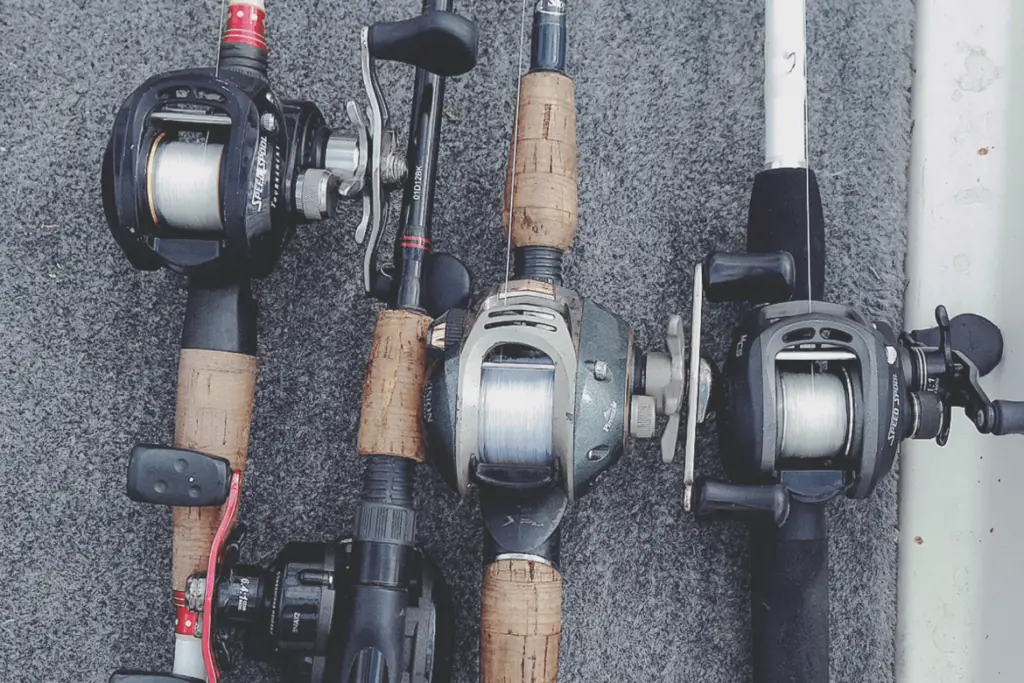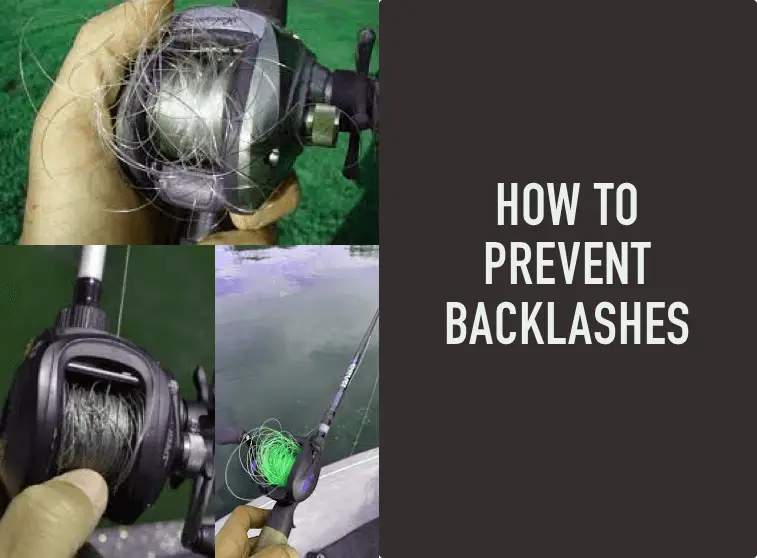Whether you are new to baitcasting reels or have had plenty years of experience you have most certainly heard of and had a backlash or a bird’s nest. This is a common fishing issue that all anglers using baitcasting reels are faced with and is one that can be frustrating and often intimidating.
So, you might be wondering what you can do to prevent backlashes when using a baitcasting reel? There are several things you can do to help prevent this from happening including: adjusting your braking system, spool tension, drag, and ensuring you have the right line and equipment for your fishing situation.
In this article we will share with you 10 simple tips that you can use to help you prevent and avoid backlashes from happening. As well as explain why they occur and how you can fix them when they do happen.
Let’s get started.
What is a Backlash & Why Do They Happen?
Before we dive into the specific things you can do to prevent a backlash from happening it’s important to first understand why they happen.
A backlash occurs when your spool is spinning faster than your line or lure can take off. This often happens when your lure slows down after casting, but the spool keeps spinning. This can result in a big, tangled mess that can be both frustrating and annoying to fix.
Although most anglers experience some level of a backlash while fishing it’s often because the spool and or brake system aren’t set up correctly for the size of lures and baits you are using.
10 Tips to Avoid Backlashing on Baitcasting Reels

Backlashing while casting can be frustrating and can prevent anglers from using baitcasting reels. However, with the right adjustments anyone can use a baitcasting reel successfully with the right setup.
Here are 10 simple tips that can help you avoid backlashes when fishing with a baitcasting reel:
1. Choose the Right Reel
First things first, having the right equipment and reel can play a big factor when using a baitcaster. That doesn’t mean you have to get the most expensive setup by any means. However, having a quality reel with certain features can go a long way and will help make your fishing experience more enjoyable.
In fact, there are certain reels like the Shimano DC series that have a computerized chip that helps control the braking system making it extremely difficult to backlash. These are great reals for anglers that have trouble with backlashes, fish in the wind, and frequently skip their baits.
If you are in this situation and are looking for a new baitcasting reel to purchase I’d highly recommend picking up the Shimano SLC DC reel. This can make things a lot easier and will help prevent backlashes with its built-in braking system.
2. Adjust Your Braking System
After you have selected the right reel and equipment the first and perhaps the most important step that can help you to avoid backlashes on your baitcasting reel is to adjust your reels braking system to match your experience and the weight of your bait and lures.
Your baitcasting reels braking system can be adjusted on the wheel dial which is located on the side of your reel. Some reels will have a switch that you can simply turn, while others you’ll need to pop off the side plate and manually adjust the knobs.
The higher the number or more knobs you have pushed in on your reel means there are more breaks on your spool. The more breaks make it easier to cast heavier lures and also makes it harder to backlash while casting. The lower the number or less breaks your spool has the easier it is to cast lighter lures and the faster your spool will spin while casting.
If you are struggling with backlashes and bird’s nests or are just learning how to use a baitcasting reel, start with more breaks or at a higher setting (8 or 9). This will give you more control and will allow less movement of your spool while you practice. From there you can adjust your reel’s brake settings until you find the right combination for you.
3. Adjust Your Spool Tension Knob
Another important component of your baitcasting reel is the tension knob. This knob allows you to further adjust and fine tune how much line comes off your spool.
Any time you are out on the water or change lures you are going to want to keep a close eye on this. If not set correctly it can easily cause backlashes and will give you trouble all day.
Every lure or bait that you have weighs a little bit different and may require you to adjust your spools tension to allow optimal casting.
You’ll want to have your tension set enough that when you click the button on your spool your lure will slowly fall. What you want to avoid is having your lure quickly fall to the floor. This will most certainly give you a backlash when you go to make a cast.
4. Avoid Casting Against the Wind
One of the most difficult casts to make with a baitcasting reel is when you are casting into the wind. If you are struggling with backlashes or birds nest it’s best to avoid casting in the wind if possible. This is especially true if you are fishing with bladed lures that tend to get caught up and slow down in the wind.
The wind will slow down the speed of your lure while your spool will continue to spin fast, often resulting in a tangled mess.
If you are faced with a situation where you need to cast in the wind, watch this video: 7 Easy Tips for Casting into the Wind (Baitcasting Tips for Beginners)
5. Choose the Right Line
A simple but yet important tip that can help you avoid backlashes is putting on the right line and line size that is recommended for your baitcasting reel.
If you put on a heavier line than what is recommended the line will try and force itself up off of your spool which can cause some problems and make it more likely that you backlash more frequently.
Some experienced anglers will sometimes use heavier line than what is recommended but oftentimes this is only when they are pitching and flipping. In most situations it’s best to stick with your reel line recommendations to avoid potential problems.
6. Avoid Hitting Objects
If you fish with a baitcasting reel long enough, you’ll eventually end up clipping a tree or banging your bait against a dock or some other object. When this does happen, your spool will overspin, and you’ll end up with a big bird’s nest.
To avoid this the best thing to do is to always keep your thumb close to the line on your spool and when you do hit an object stop the line with your thumb. This simple trick can save you a lot of time and can prevent some nasty backlashes.
7. Don’t Overfill Your Spool
Another common mistake that many anglers make when fishing with a baitcasting reel is that they put too much line on their reel. Overfilling your line to your reel’s capacity will cause the line to jump more easily off your spool and can cause trouble while casting.
The right amount of line on your casting reel will allow your reel to function as expected and will prevent the line from being loose and coming off your spool. However, if you under fill your spool with a line you’ll have a hard time getting distance from your casts. That’s why putting the right amount of line on is key.
Here are some tips that will help make sure you spool a baitcasting reel the right way: How to Spool a Baitcasting Reel.
8. Adjust Your Drag
Another simple tip that will not only help you with your backlashing issues but will also make sure you land your prize catch is to adjust your reel’s drag.
Most baitcasting reels have a star shaped drag system where you can loosen or tighten the drag on your reel by turning the star wheel which is located beneath the handle.
Too loose of drag can be hard for you to manage your lures and difficult to reel fish in. On the other hand, a drag that is too tight makes it easier for fish to break off. That’s why dialing in your drag setting to your specific fishing situation is key.
Here is some more information on how to dial in your reels drag: How to Set Your Reel’s Drag.
9. Spool Your Line Properly & Tight
Another important step that you can do to prevent backlashes when you are on the water is to make sure you spool your line the right way when you are getting it setup.
When first adding a line to your baitcasting reel you want to make sure your spool and the way the line is coming off its packaging is in the same direction. This will help with line twists and prevent future problems.
You’ll also want to make sure your line goes on your spool tight. This is best achieved if you can have tension on the other side of the line. If your line goes on loose, you’ll have issues casting and backlashes will be more likely to occur in the future.
Here are some tips on how to spool your baitcasting reel properly: How To Spool A Baitcaster | Reduce Line Twists, Backlashes
10. Practice Makes Perfect
If you are a beginner and or don’t have much experience using a baitcasting reel it can be a little bit of a learning curve. Don’t worry we have all been there and it can be challenging when you first start learning.
When I first teach other anglers how to use a baitcasting reel I’ll often start them on a high break setting and use a reel that has monofilament. I feel like this is the best setup to start out and when backlashes do occur it’s easy to get them fixed.
Keep practicing and use the tips and tricks we have discussed in this article, and you’ll be well on your way to mastering the art of using a baitcasting reel.
How to Fix a Backlash
Let’s be honest, despite our best efforts to avoid the dreaded backlash they are still going to happen at some point. That’s why it’s important to understand how to remove them from a baitcaster when they do happen.
Here is what you can do to fix a backlash after it occurs:
Additional Fishing Resources
- What Pound Test of Fishing Line to Use [Complete Guide]
- The 5 Best Baitcasting Combinations for Beginners
- Best Braided Fishing Line for Bass
- Bass Fishing Gear Ratios [Ultimate Reel Guide]
- The 5 Best Bass Fishing Rigs for Beginner’s
Baitcasting Reel FAQ
Is there a baitcaster that won’t backlash? There isn’t a baitcasting reel that will completely get rid of backlashes. However there are some higher end reels like the Shimano Curado DC that has a built in computer chip that controls the speed of the spool. This chips makes it pretty dang hard to get a backlash while casting, but it still can happen.
How do you use a baitcasting reel without backlash? Backlashes are apart of using baitcasting reels but there are certain things you can do to avoid them. The best way to use a baitcasting reel without backlashing it to adjust your reels braking system, tension knob and drag to match the weight of your lure or bait.
Why do I keep getting backlash on my baitcaster? The most common reason why you are backlashing on your cast is because you reel reels breaks isn’t properly setup. Turn you braking system to a higher number, this will keep you from backlashing.
Final Thoughts
Anyone that has fished with a baitcasting reel knows what it’s like to get a backlash and how frustrating it can be at times. It can happen to even the most experienced and skilled anglers.
When you do get a backlash don’t stress about it. It happens to all of us. However
Luckily now you know what you can do to avoid getting backlashes on a consistent basis and how to fix them when they do happen.

